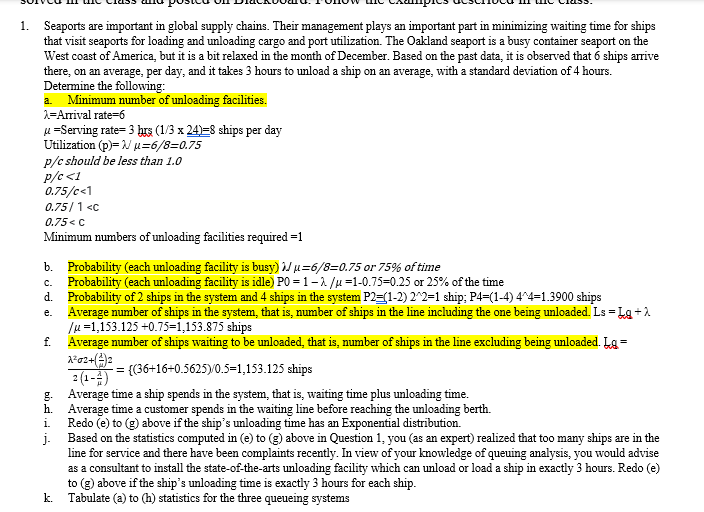1. Seaports are important in global supply chains. Their management plays an important part in minimizing waiting time for ships that visit seaports for loading and unloading cargo and port utilization. The Oakland seaport is a busy container seaport on the West coast of America, but it is a bit relaxed in the month of December. Based on the past data, it is observed that 6 ships arrive there, on an average, per day, and it takes 3 hours to unload a ship on an average, with a standard deviation of 4 hours. Determine the following: a. Minimum number of unloading facilities. λ=Arrival rate=6 u=Serving rate= 3 hrs (1/3 x 24)-8 ships per day Utilization (p)=2 μ=6/8=0.75 p/c should be less than 1.0 p/c<1 0.75/c<1 0.75/1
1. Seaports are important in global supply chains. Their management plays an important part in minimizing waiting time for ships that visit seaports for loading and unloading cargo and port utilization. The Oakland seaport is a busy container seaport on the West coast of America, but it is a bit relaxed in the month of December. Based on the past data, it is observed that 6 ships arrive there, on an average, per day, and it takes 3 hours to unload a ship on an average, with a standard deviation of 4 hours. Determine the following: a. Minimum number of unloading facilities. λ=Arrival rate=6 u=Serving rate= 3 hrs (1/3 x 24)-8 ships per day Utilization (p)=2 μ=6/8=0.75 p/c should be less than 1.0 p/c<1 0.75/c<1 0.75/1
Practical Management Science
6th Edition
ISBN:9781337406659
Author:WINSTON, Wayne L.
Publisher:WINSTON, Wayne L.
Chapter12: Queueing Models
Section: Chapter Questions
Problem 59P
Related questions
Question
COMPARISION AMONG DIFFERENT QUEUING SYSTEMS.
I NEED HELP WITH PART G,H,I,J &K.

Transcribed Image Text:1. Seaports are important in global supply chains. Their management plays an important part in minimizing waiting time for ships
that visit seaports for loading and unloading cargo and port utilization. The Oakland seaport is a busy container seaport on the
West coast of America, but it is a bit relaxed in the month of December. Based on the past data, it is observed that 6 ships arrive
there, on an average, per day, and it takes 3 hours to unload a ship on an average, with a standard deviation of 4 hours.
Determine the following:
a. Minimum number of unloading facilities.
λ=Arrival rate=6
μ = Serving rate=3 hrs (1/3 x 24)-8 ships per day
Utilization (p)=
μ-6/8=0.75
p/c should be less than 1.0
p/c<1
0.75/c<1
0.75/1 <c
0.75<C
Minimum numbers of unloading facilities required =1
b. Probability (each unloading facility is busy)
μ-6/8-0.75 or 75% of time
Probability (each unloading facility is idle) P0=1-λ/μ-1-0.75-0.25 or 25% of the time
C.
d. Probability of 2 ships in the system and 4 ships in the system P2=(1-2) 2^2=1 ship; P4=(1-4) 4^4=1.3900 ships
e.
Average number of ships in the system, that is, number of ships in the line including the one being unloaded. Ls = Lg + A
/u=1,153.125 +0.75=1,153.875 ships
Average number of ships waiting to be unloaded, that is, number of ships in the line excluding being unloaded. La=
λέσ2+(3) 2
= {(36+16+0.5625)/0.5-1,153.125 ships
2 (1-4)
f.
g.
h.
1.
j.
Average time a ship spends in the system, that is, waiting time plus unloading time.
Average time a customer spends in the waiting line before reaching the unloading berth.
Redo (e) to (g) above if the ship's unloading time has an Exponential distribution.
Based on the statistics computed in (e) to (g) above in Question 1, you (as an expert) realized that too many ships are in the
line for service and there have been complaints recently. In view of your knowledge of queuing analysis, you would advise
as a consultant to install the state-of-the-arts unloading facility which can unload or load a ship in exactly 3 hours. Redo (e)
to (g) above if the ship's unloading time is exactly 3 hours for each ship.
Tabulate (a) to (h) statistics for the three queueing systems
k.
Expert Solution
This question has been solved!
Explore an expertly crafted, step-by-step solution for a thorough understanding of key concepts.
Step by step
Solved in 6 steps with 1 images

Follow-up Questions
Read through expert solutions to related follow-up questions below.
Follow-up Question
Part e & f is incorrect
e.)Ls=3.125+0.75=3.875 ships
f.) Lq=(6^2(1/6)^2+0.75^2)/2(1-.75)=3.125 ships
g.)Ws=3.875/6=0.6458 days or 15.5 hours
Solution
Recommended textbooks for you

Practical Management Science
Operations Management
ISBN:
9781337406659
Author:
WINSTON, Wayne L.
Publisher:
Cengage,

Practical Management Science
Operations Management
ISBN:
9781337406659
Author:
WINSTON, Wayne L.
Publisher:
Cengage,